Influenza monthly update, March 2019
In the WHO Eastern Mediterranean Region, influenza activity continues to increase in the month of March in many countries reporting data to FluNet and EMFLU namely, Afghanistan, Bahrain, Egypt, Iran (Islamic Republic of), Iraq, Jordan, Kuwait, Lebanon, Morocco, occupied Palestinian territory (oPt), Oman, Pakistan, Qatar, Saudi Arabia, Sudan, Syrian Arab Republic and Tunisia.
In March 2019, roportion of tested cases for influenza in EMR is 88% out of 9,159 enrolled cases, 18% of the tested cases is positive and 82% is negative.
Figure 1: Influenza geographic spread by type and subtypes, March 2019
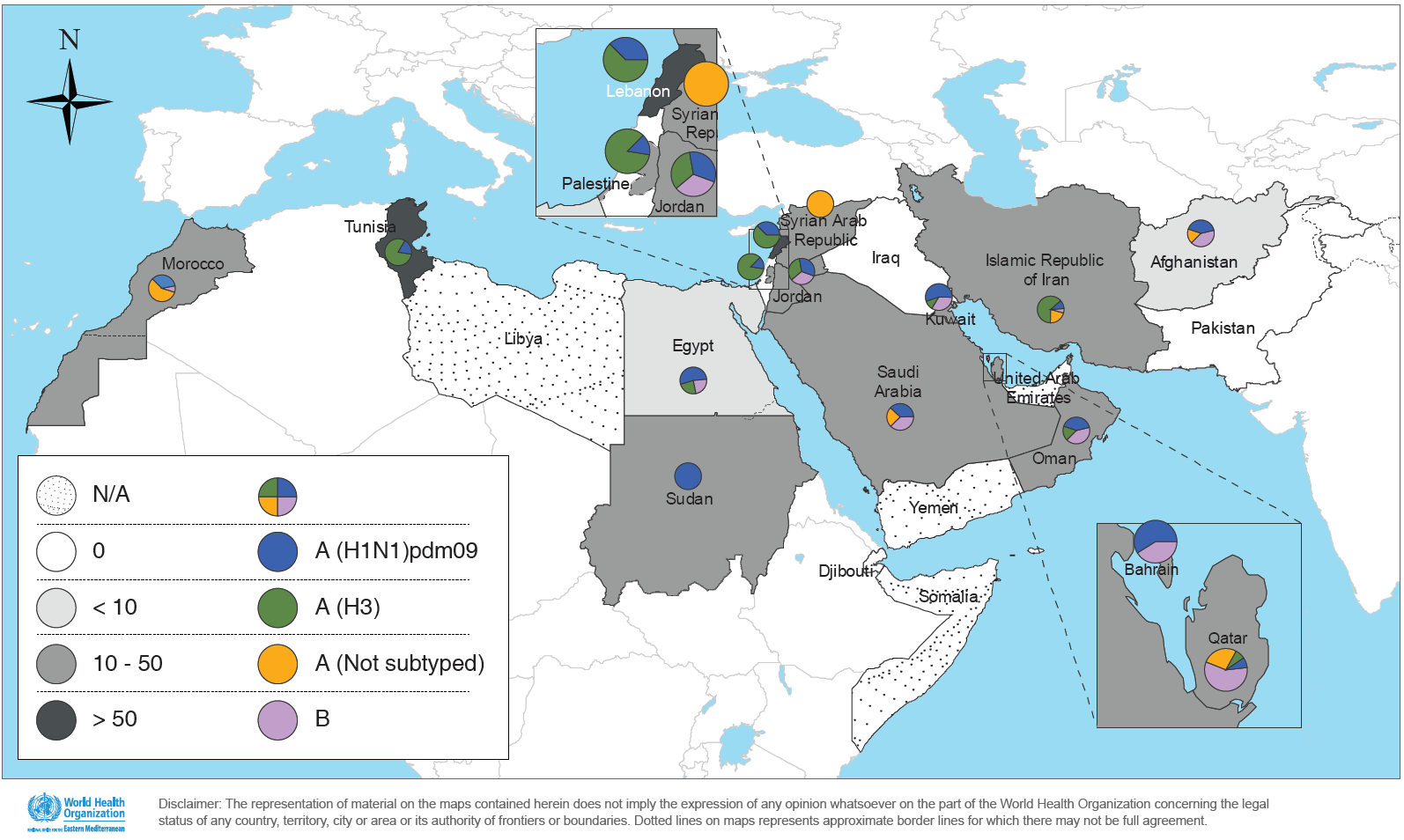
Influenza activity by sub-type
• In March 2019, no new cases of human influenza A(H5N1) were reported in Egypt.
• In the northern Africa influenza transmission zone, influenza activity continued to decrease in Egypt, Morocco and Tunisia with all seasonal influenza subtypes co-circulating.
• In the western Asia influenza transmission zone, Oman, Saudi Arabia, Qatar and Kuwait continued reporting high co-circulation of influenza types A and B with influenza B virus predominating in Qatar. Jordan, Lebanon, reported cocirculation of A(H1N1)pdm09 and A(H3N2) and few B viruses while oPt and Iraq reported circulation of Influenza A(H1N1)pdm09 and A(H3N2) viruses, with slightly more detections of A(H3N2).
• In southern Asia transmission zone, influenza activity continued to decrease with all seasonal influenza subtypes co-circulating in Afghanistan and Iran (Islamic Republic of) with A(H3N2) predominating.
Source of transmission zones: http://www.who.int/csr/disease/swineflu/transmission_zones/en/
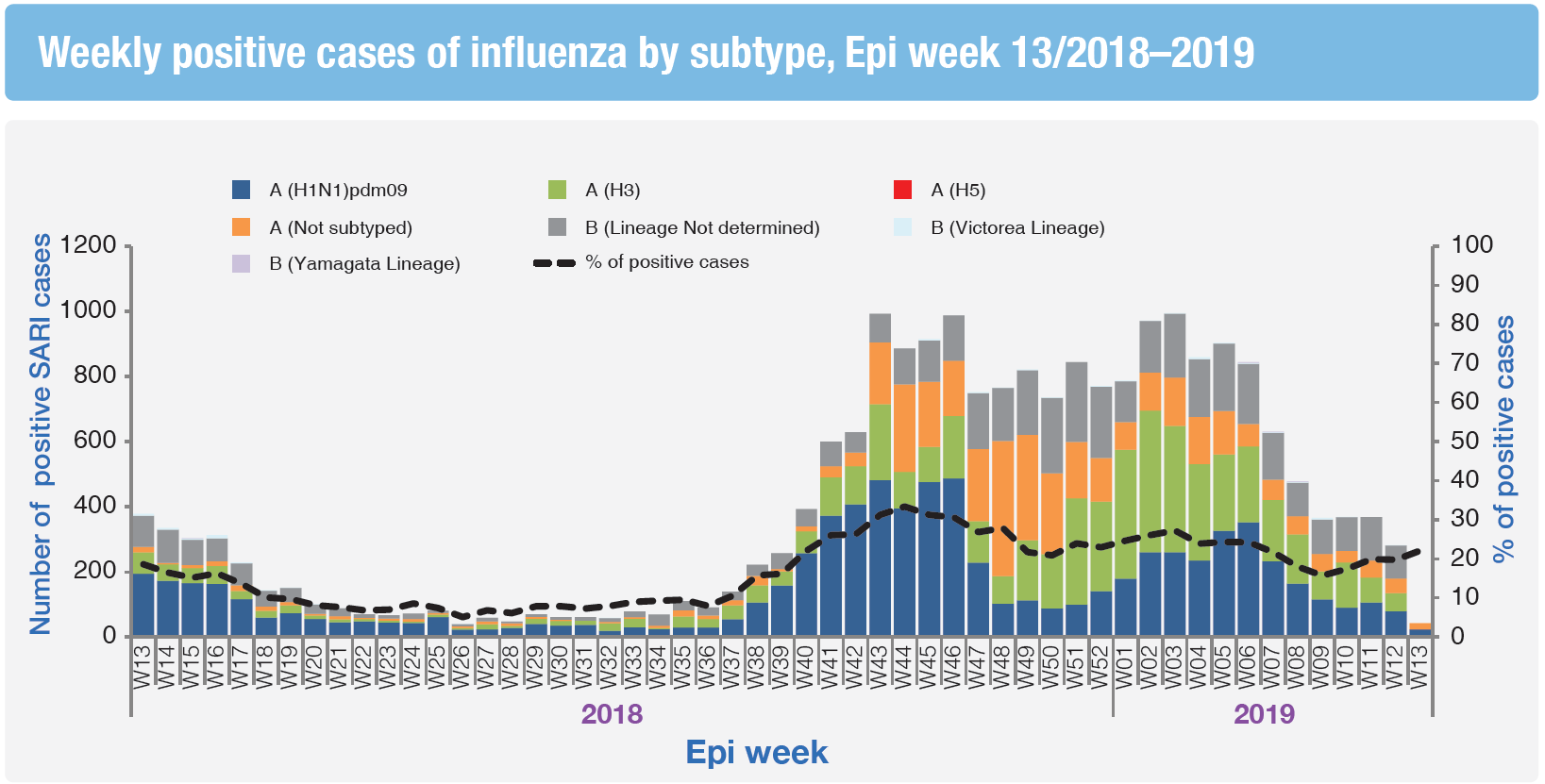
Circulating influenza viruses by subtype
• During March 2019, national influenza centres and influenza laboratories in the Region tested a total of 8,036 specimens for influenza viruses of which 1,453 tested positive (18%).
• The average percentage of positivity rates is 18%, with highest positivity rate recorded in Lebanon, Saudi Arabia and Tunisia.
• Of the viruses tested; 977 (68%) were influenza A viruses, including 413 (29%) influenza A(H1N1)pdm09 virus, 359 (25%) were influenza A(H3) virus and 205 (14%) were influenza A(not subtyped) virus. Influenza B (Lineage Not determined) virus accounted for 443 (31%).
Figure 3: Circulating influenza viruses in the EMR by subtype, March 2019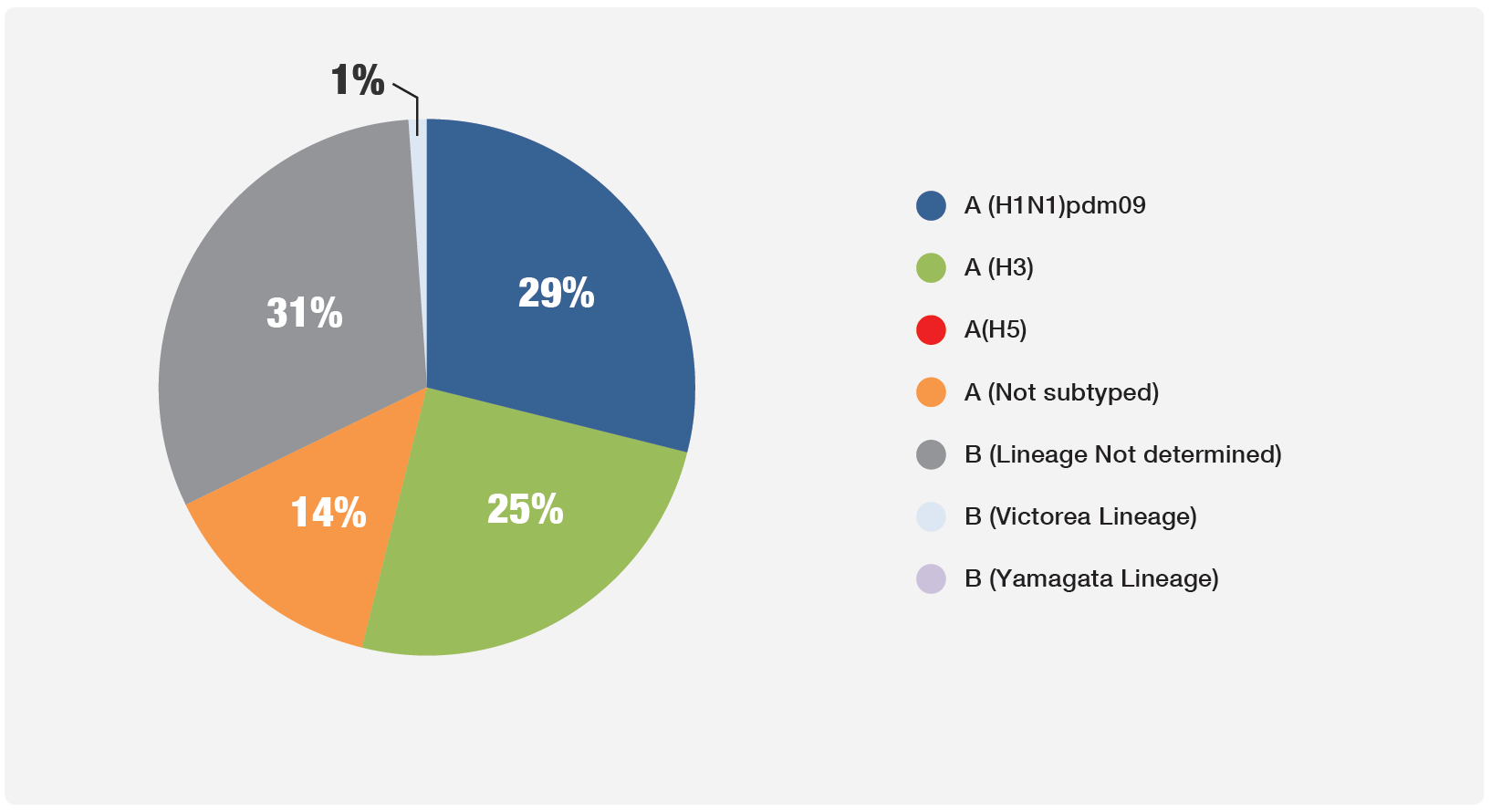
Source: FluNet and EMFLU
Related link
منظمة الصحة العالمية تدين مقتل طبيبين بسبب الصراع في ليبيا
طرابلس، ليبيا، ٨ أبريل ٢٠١٩— تدين منظمة الصحة العالمية بشدة مقتل طبيبين كانا يعملان على تقديم الخدمات المُلحة للمدنيين في طرابلس.
وأكد المدير الإقليمي لمنظمة الصحة العالمية لشرق المتوسط الدكتور أحمد المنظري على أنه "من غير المقبول أن يتم استهداف العاملين الصحيين أثناء النزاع المسلح. يجب على أطراف الصراع احترام القانون الدولي الإنساني وضمان سلامة العاملين الصحيين والمرافق الصحية. لقد خاطر هؤلاء الأطباء بحياتهم لإخلاء الجرحى من مناطق النزاع، واستهدافهم والمرافق الصحية في مثل هذه الأوقات يزيد الوضع تعقيداً بالنسبة للمدنيين المحاصرين جراء هذا الصراع".
لقد وثقت منظمة الصحة العالمية أكثر من ٤٦ اعتداءً على العاملين الصحيين والمرافق الصحية خلال الفترة من ٢٠١٨- ٢٠١٩ في جميع أنحاء ليبيا. وتسببت هذه الهجمات في مقتل ٨ من العاملين الصحيين والمرضى وجرح ٢٤ آخرين. ومع استمرار الصراع المحتدم منذ سنوات في ليبيا، تعرضت المئات من مراكز الرعاية الصحية الأولية وأكثر من ٢٠ مستشفى للضرر والدمار أو الإغلاق.
ويضيف الدكتور المنظري: "هذه الهجمات على المرافق الصحية تحرم آلاف الأشخاص من الرعاية الصحية الأساسية. لذا ندعو جميع الأطراف إلى احترام الالتزامات الدولية وضمان قدرة العاملين الصحيين على أداء مهامهم المنقذة للحياة".
لمزيد من المعلومات :
Misbah M. Sheikh
Manager External Relations
Health Emergencies Department
WHO Regional Office for the Eastern Mediterranean
Email:
Cell: +20 1212 733 994
Afghan children learning to paint at the Aschiana Foundation paint Primary Health Care
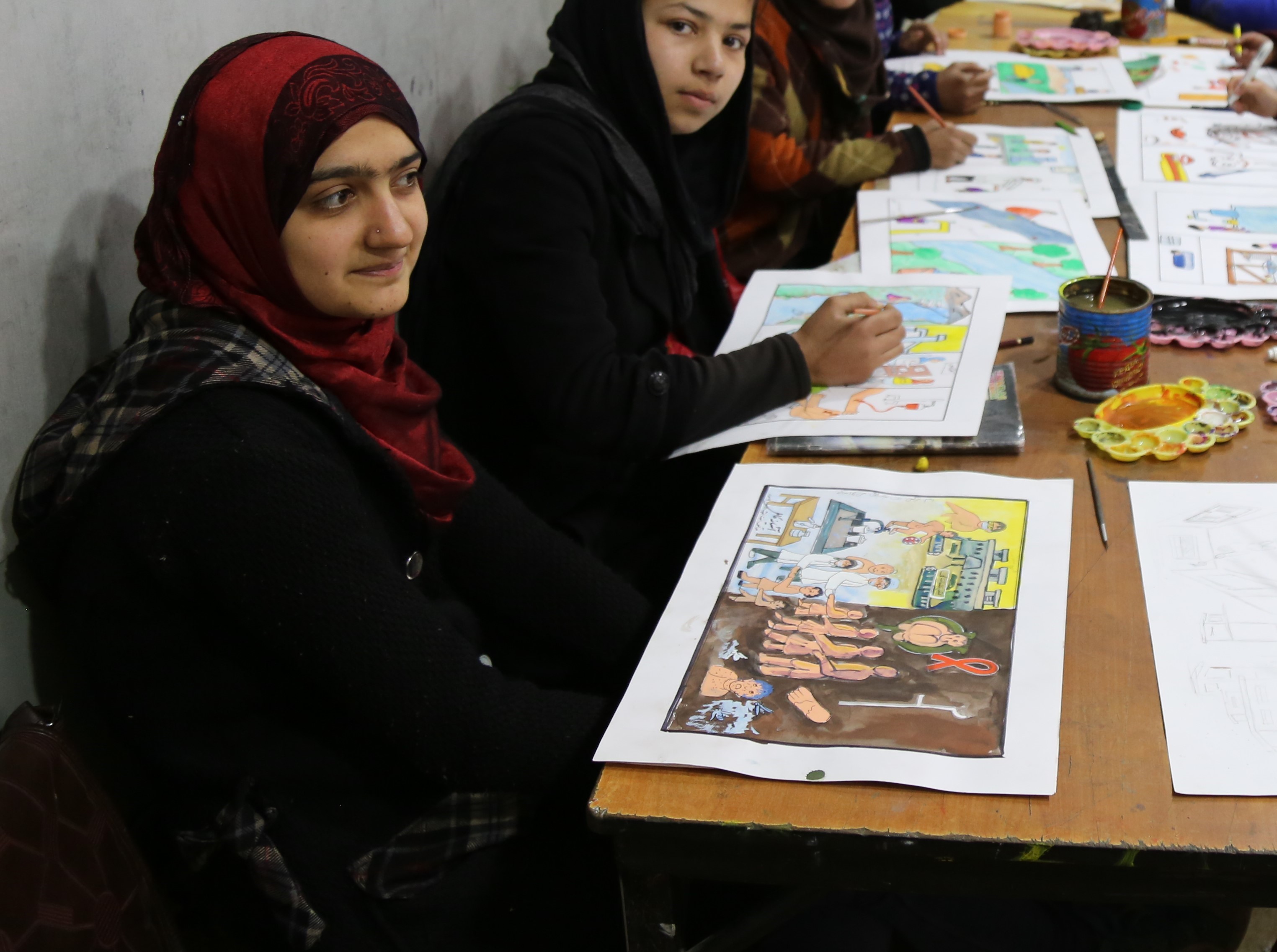
Every year on the occasion of World Health Day (WHD), WHO across the Asia and the Pacific Region, which includes Afghanistan, organizes an art competition for school children aged 8 to 18 years. The aim is to raise children’s awareness on different health topics.
For 2019 the focus of the WHD was primary health care. WHO Afghanistan worked with children from Aschiana foundation in Kabul to produce works of art portraying Primary Health Care as they know it.
Some paintings were selected and sent to Cairo Egypt for evaluation and competition with other countries. Nargis, 15, who wants to be a medical doctor in the future, said her painting will win the competition.
Ayesha, 9, who wants to be a famous artist in the future, said her painting will win for Afghanistan.
Nargis, 15, said, “people living without primary healthcare can't have a good life. They are as if in the dark. All of us have to help people out to brightness with primary health care for all".
Nargis won the 5th place on the art competition and received cash incentive, but also a certificate of merit from WHO.
WHO provides support to Pakistan’s immunization programme to strengthen routine immunization in underserved areas
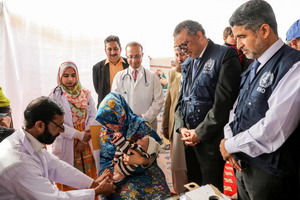 WHO Director-General Dr Tedros Adhanom Ghebreyesus and WHO Regional Director for the Eastern Mediterranean Dr Ahmed Al-Mandhari attended a vaccination session during their visit to the Shah Allah Tiddy Health facility in Islamabad on 6 January 201910 January 2019 – WHO has been providing support to Pakistan’s Ministry of National Health Services, Regulations and Coordination and health departments in the Sindh, Baluchistan and Khyber Pakhtunkhwa provinces to strengthen routine immunization in underserved areas and ensure equitable access to vaccines for children from these areas.
WHO Director-General Dr Tedros Adhanom Ghebreyesus and WHO Regional Director for the Eastern Mediterranean Dr Ahmed Al-Mandhari attended a vaccination session during their visit to the Shah Allah Tiddy Health facility in Islamabad on 6 January 201910 January 2019 – WHO has been providing support to Pakistan’s Ministry of National Health Services, Regulations and Coordination and health departments in the Sindh, Baluchistan and Khyber Pakhtunkhwa provinces to strengthen routine immunization in underserved areas and ensure equitable access to vaccines for children from these areas.
From 12 November 2018 to 8 January 2019, 4000 vaccination teams were supported to increase access to vaccination services for children in slum and remote areas against 10 potentially fatal and acute diseases. More than 835 000 children were vaccinated with approximately 1 377 000 doses of various vaccines, including Bacillus Calmette–Guérin, oral polio, inactivated polio, pentavalent, pnemuococcal, measles and rotavirus vaccines.
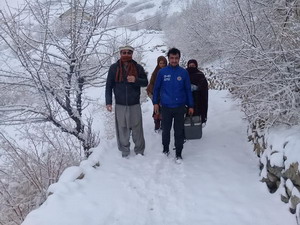 WHO praises the tremendous dedication of the vaccinators and Lady Health Workers who, in some cases, travelled great distances in difficult weather and over difficult terrain to administer the much needed vaccines to children. Local communities exhibited extraordinary cooperation with vaccination teams in providing them with vaccination stations and bringing their children to be vaccinated.
WHO praises the tremendous dedication of the vaccinators and Lady Health Workers who, in some cases, travelled great distances in difficult weather and over difficult terrain to administer the much needed vaccines to children. Local communities exhibited extraordinary cooperation with vaccination teams in providing them with vaccination stations and bringing their children to be vaccinated.
To ensure the success of these outreach activities, microplans at the health facility level were updated based on the development of the high quality microplans for the measles campaign. Monitoring and field supervision visits were also enhanced. More than 1400 supervisors and monitors from the national EPI, WHO, UNICEF and various partners participated in monitoring the outreach activities.
In a highly successful measles vaccination campaign conducted in Pakistan in October 2018 more than 37 million children in Pakistan, with a coverage rate of more than 95%, were immunized against measles.


